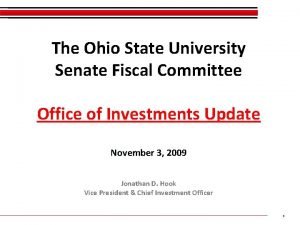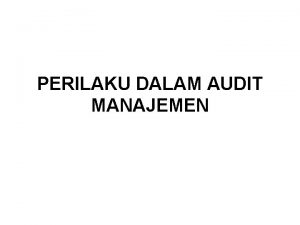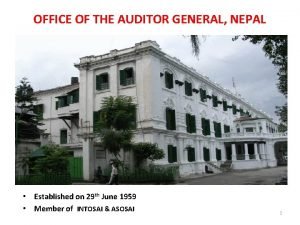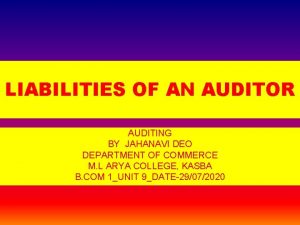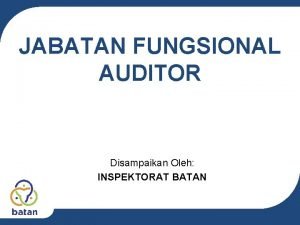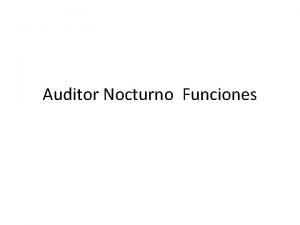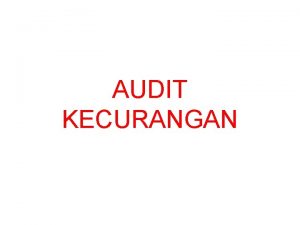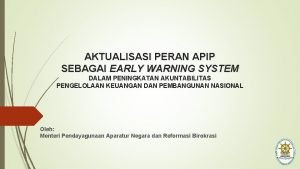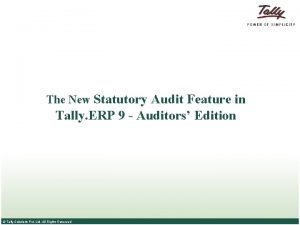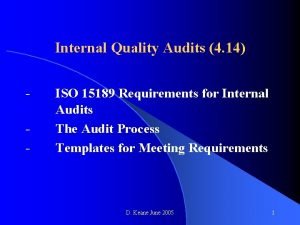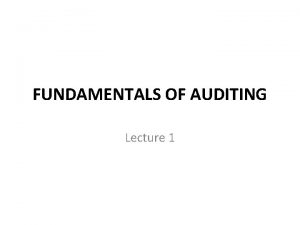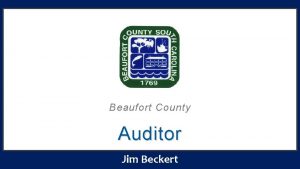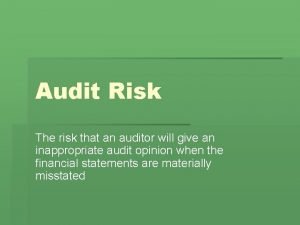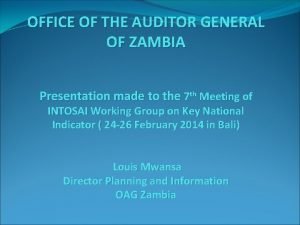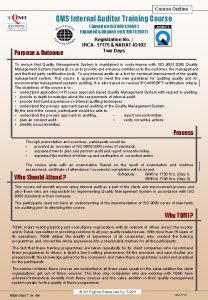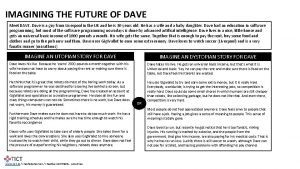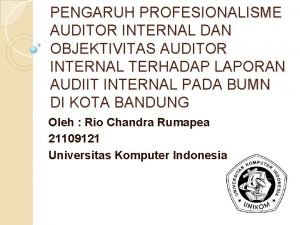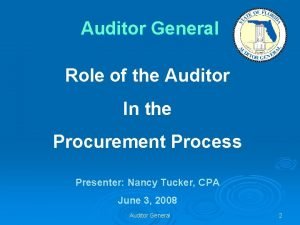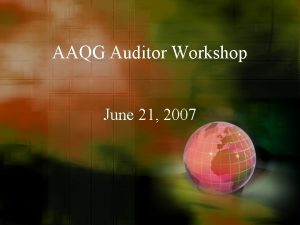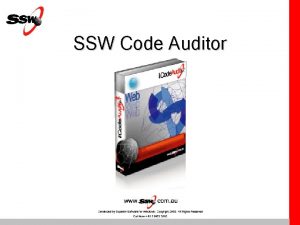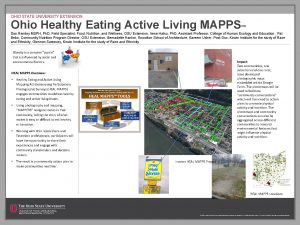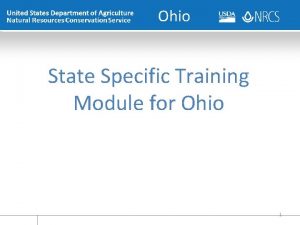DAVE YOST Ohio Auditor of State Financial Health











































- Slides: 43

DAVE YOST Ohio Auditor of State { Financial Health Indicators (FHI) Presented by: Leanna Abele, CPA Assistant Chief Deputy Auditor November 2, 2017 1

Overview • Development of Financial Health Indicators (FHI) and Report • Predictors of Fiscal Stress • FHI Challenges • Specific Indicators/FAQs • FHI Data Sheet/Heat Map • Enhancements for 2016 Reports/Heat Maps • FHI Results • Questions? ? ? 2

Development of the Financial Health Indicators • Identification of the Financial Health Indicators (FHI) began in 2011 when Auditor Yost took office and wanted to devise a way to help communities avoid being declared in a state of fiscal distress. • The goal was to identify cities and counties that may be experiencing fiscal stress and provide support to these entities in a proactive manner rather than a reactive manner. • Research of indicators used by other states and other references was utilized to determine the best indicators of an entity’s financial stability that were also readily available from the financial statements and audit results of cities and counties. 3

Development of the Financial Health Indicators • Data was collected from the audited financial statements/audit results to build a 5 -year history of financial data to calculate the chosen financial health indicators. • The results of the indicators for cities and counties already placed in fiscal caution, watch or emergency were analyzed for periods prior to their fiscal distress. • A clearly identifiable trend of fiscal stress emerged to reflect if the FHI tool had been in place at the time, those entities could have requested assistance two to three years prior to their financial stress worsening to the point of declaration of fiscal caution, watch or emergency. 4

Development of the Financial Health Indicators • These trends helped establish benchmarked criteria, using averages based on five years of historical data from all Ohio counties and cities, to set benchmarks for the Financial Health Indicators. • The intent is to continue to monitor and update the benchmarks every five years, if necessary for changing trends. 5

Development of the Financial Health Indicators Important!! • The FHI report is not intended to criticize the operating decisions made by individual entities. • No one financial indicator by itself is of use in identifying overall fiscal stress. These indicators must be considered together to obtain insight as to whether or not an entity is experiencing the early signs of fiscal stress; however, individual indicators identify specific areas for review by the entity. • The FHI report is a useful tool to provide a “fiscal physical” and to identify those entities that are on a path to fiscal stress, which could benefit from proactive actions to alleviate the stress. • The goal is to bring awareness and initiate discussion about fiscal health in Ohio. 6

Financial Health Indicator Report • For each reporting year, each city’s and county’s financial health indicators (FHI) will be generated twice: o Preliminary – at the time of their final, unaudited Hinkle System annual financial statement report submission o Final – at the time of the completion of the financial audit. • Each city/county will receive its FHI report with a supporting data sheet. o The preliminary FHI report is available via the entity’s AOS e. Services account and on the AOS website immediately upon completion of the entity’s annual Hinkle System filing. o The final FHI report is available via the entity’s AOS e. Services account once the entity’s auditors complete the audit adjustments application in the Hinkle System; however, the final FHI report is not available on the website until the associated audit report is publicly released. • NOTE: A city or county must present its financial statements on a consistent accounting basis for seven (7) years in order to generate their FHIs. The FHI report for entities presenting their financial statements on a regulatory cash or varying accounting bases will be a one-page explanation of why their FHIs cannot be generated. 7

Financial Health Indicators Report • There are seventeen (17) FHIs applicable to GAAP entities, with fifteen (15) of those applicable to cash/modified cash entities. • Since there a significant number of FHIs, they are not weighted. • Three FHI Indicator classifications (using “stop-light” colors) o Critical Outlook (red) o Cautionary Outlook (yellow) o Positive Outlook (green) • Calculations to determine Cautionary or Critical Outlook differ based on the indicator. If the indicator does not meet the Cautionary or Critical Outlook measure, it defaults to Positive Outlook. 8

Financial Health Indicators Report • The FHI Report Summary page includes: o The results of the applicable 17 FHIs at a glance: 1 2 3 4 5 6 7 8 9 10 11 12 13 14 15 16 17 0 o The definitions of the indicator results: Ø Critical Outlook (red) - The more serious of the outcomes of the FHI analysis. An indicator with a Critical Outlook signals a potential high risk of fiscal stress. The entity should review the cause of the Critical Outlook indicator and consider steps necessary to alleviate the condition, if necessary. 9

Financial Health Indicators Report Ø Ø Ø Cautionary Outlook (yellow) - Although not as serious as an FHI with a Critical Outlook, an indicator with a Cautionary Outlook signals a situation of which the entity should be aware. The entity should review the cause of the Cautionary Outlook indicator since, left unchecked, it could develop into a Critical Outlook indicator. Positive Outlook (green) - This entity does not meet a Critical or Cautionary Outlook as defined above, but entities should still review the data. Not Applicable (black) - This entity did not report data for this indicator or the data for determination of the indicator is unavailable 10

Predictors of Overall Fiscal Stress • For entities already in fiscal stress, it was determined that had met at least six (6) indicators with a “critical outlook” when reporting on a GAAP basis (four (4) when reporting on a cash/modified cash basis) • Two to three years prior, these entities met a combination of eight (8) “critical outlook” and/or “cautionary outlook” indicators when reporting on a GAAP basis (combination of six (6) when reporting on a cash/modified cash basis). 11

FHI Challenges • In Ohio, there is currently no standard chart of accounts for cities or counties; therefore, financial statement line items may differ in name or content. • The results “potentially” indicate stress is occurring. Some entity decisions will trigger an indicator as having a “critical outlook” or “cautionary outlook. ” The citizenry or uninformed readers, without review of the entity’s audited financial statements, may draw incorrect conclusions. The FHI reports are automated reports generated from the keyed data from the entity’s Hinkle System filing. o We refer to it as a “fiscal physical, ” so similar to a medical physical, the results are based on expected outcomes. o 12

Specific Indicators Unrestricted Balances Indicators 1, 3, and 13 – Unrestricted Net Assets/Position of GTA Indicators 2, 4, and 14 – Unassigned General Fund Balance Indicators 1 and 2 – Look at the balance – is it zero or negative or lower than prior year? Indicators 3 and 4 – Look at the trend of the balance – declining over multiple years and by how much? Indicators 13 and 14 – Look at how many days these balances could sustain the entity’s operations? Also – Indicator 15 – Looks at how many days the entity’s cash and investments will sustain operations? 13

FHI Report – Individual Indicators #1 & 2 Positive Outlook Cautionary Outlook Critical Outlook – Zero or negative amount Cautionary Outlook – Decline between the current and prior year by more than a 1% 14

FHI Report – Individual Indicators #3 & 4 Positive Outlook Cautionary Outlook Critical Outlook – Current and 2 of 3 previous periods reflect zero or negative OR rapidly declining trend of drop in each of last 3 years with overall drop of > 20% Cautionary Outlook – Decline in each of last 3 years with overall drop of 10 -20% 15

FHI Report – Individual Indicators #13, 14 & 15 Positive Outlook Cautionary Outlook Critical Outlook Cr Critical Outlook – Zero days or below Cautionary Outlook – Less than 30 days 16

Specific Indicators Reserves in the General Fund Indicator 5 – Total General Fund Balance as % of General Fund Revenues • The larger the reserve, the better the entity is able to absorb, in the short term, the impact of sudden revenue loss or significant increases in operating costs. • This indicator identifies a low reserve of fund balance even if Indicators 1 through 4 do not indicate negative unrestricted net assets/position or unassigned general fund balance. • Critical Outlook – Negative percentage or very low percentage (<4%) OR if fund balance is less than a two month carryover (17%), a rapidly declining trend defined as a drop of 10% or greater over a 3 year period. • Cautionary Outlook – Low percentage (< 8%) OR if fund balance is less than a two month carryover (17%), a declining trend drop of 5%-10% over a 3 year period OR if the fund balance represents less than 6 months (50%) of current revenues, a decline in each of last 3 years. 17

FHI Report – Individual Indicators Indicator #5 Positive Outlook 18

FHI Report – Individual Indicators Low percentage – between 4 & 8% Indicator #5 Cautionary Outlook Fund balance < 17% and 3 year drop of 5% - 10% Fund balance of < 50% & decline each last 3 years 19

FHI Report – Individual Indicators Indicator #5 Critical Outlook Negative or very low (4% or less) percentage Fund balance < 17% and 3 year drop of 10% or more 20

Specific Indicators Own Source (Local) vs Intergovernmental Revenues • Indicator 6 – Property Tax Revenues • Indicator 7 – Income Tax Revenues (city) • • • Imposed by the entity Significant revenue sources Indicators look at percentage of decrease over time. • By contrast, Indicator 10 – is the percentage of General Fund revenues that represent intergovernmental revenues (state and federal). Over-reliance on external resources (grants, entitlements or shared revenues) are vulnerable to cuts. 21

FHI Report – Individual Indicators Indicator #6 Positive Outlook Cautionary Outlook Critical Outlook – If property tax revenues represent 7 -20% of total General fund revenues, a trend of declining property tax revenue over the last three (3) years in excess of 20% OR if property tax revenues represent greater than 20% of total General fund revenues, a trend of declining property tax revenue over the last three (3) years in excess of 10%. Cautionary Outlook – Decrease in property tax revenue from the current to the prior year by more than 1%. 22

FHI Report – Individual Indicators Indicator #7 Positive Outlook Cautionary Outlook Critical Outlook No graph available since no city currently meets this criteria. Critical Outlook – If income tax revenue represent 7 -20% of total General fund revenues, a trend of declining applicable tax revenue over the last three (3) years in excess of 20% OR if income tax represents greater than 20% of total General fund revenues, a trend of declining applicable tax revenue over the last three (3) years in excess of 10%. Cautionary Outlook - – Decrease in income tax revenue from the current to the prior year by more than 1%. 23

FHI Report – Individual Indicators Indicator #10 Positive Outlook Cautionary Outlook Critical Outlook – Ratio greater than 20% Cautionary Outlook – Ratio between 15% - 20% 24

Specific Indicators Expenditures Exceeding Revenues • Indicator #8 – Percentage of General Fund Revenues that Exceed General Fund Expenditures • Indicator #9 – General Revenues of the Govt. Type Activities (GTA) as a Percentage of Net Expenses of GTA. • Reflects if an operating deficit exists • Trend of operating deficits indicates potential financial hardship – results in decreases in balances. 25

FHI Report – Individual Indicators Indicator #8 Positive Outlook Cautionary Outlook Critical Outlook –Negative percentage Cautionary Outlook – Low percentage (<1/20 th or 5%) 26

FHI Report – Individual Indicators Indicator #9 Positive Outlook Cautionary Outlook Critical Outlook – Ratio less than 100% Cautionary Outlook – Declining trend of at least three years 27

Specific Indicators Indicator 11 – Condition of Capital Assets • Looks at the accumulated depreciation as a percentage of depreciable capital assets. • A high percentage indicates asset replacement is imminent and the entity may be delaying replacement of assets or significant repairs for cash flow purposes. • When improving or replacing assets becomes absolutely necessary, may contribute to financial hardship on an already strained budget. 28

FHI Report – Individual Indicators Indicator #11 Positive Outlook Cautionary Outlook Critical Outlook – Ratio greater than 70% Cautionary Outlook – Ratio between 50% - 70% NOTE: This indicator does not apply to cash or modified cash basis financial statements. 29

Specific Indicators Indicator 12 Debt Service Expenditures as a Percentage of Total Revenues • Higher debt service expenditures to total revenues is unfavorable since the entity spends more of its current budget on debt repayment. • Indicator will trigger when: Entities “rollover” debt (expenditure is operating but proceeds are “other financing resource”) o Entities pay debt off early o 30

Specific FAQ Indicator 12 Debt Service Expenditures as a Percentage of Total Revenues FAQ • Q: If Indicator 12 reflects a “critical” outlook (red) or “cautionary” outlook (yellow), is that always reflective of fiscal stress? • A: No, as stated in an earlier FAQ, many times local leaders have made conscious decisions that may, because the FHI report is an automated process, trigger an indicator as having a “critical” (red) or “cautionary” (yellow) outlook. Those decisions are purposeful and usually are not indicative of a problem. For example, an entity may “rollover” short-term note debt to take advantage of more favorable rates or while waiting for an event to occur before incurring long-term debt. Similarly, an entity may be fiscally strong and able to pay longterm debt early. In these situations, the debt service expenditures would increase and likely trigger a “red” or “yellow” #12 indicator; however, the entity has make an informed-decision that is not reflective of fiscal stress. 31

FHI Report – Individual Indicators Indicator #12 Positive Outlook Cautionary Outlook Critical Outlook – Ratio greater than 15% (cities) Cautionary Outlook – Ratio between 12%-15% (cities) NOTE: The percentages are based on historical rolling data by entity type and will continue to be analyzed in the future to determine if modification is required. 32

FHI Report – Individual Indicators Indicator #16 Total Percentage of Liabilities to Net Assets/Position This indicator identifies entities that may be over-extended in terms of the percentage of every dollar which is owed to others. Negative ratio represents negative net assets. NOTE: The percentages are based on historical rolling data by entity type and will continue to be analyzed in the future to determine if modification is required. NOTE: This indicator does not apply to cash or modified cash basis financial statements. 33

FHI Report – Individual Indicators Indicator #16 Positive Outlook Cautionary Outlook Critical Outlook – Negative ratio OR ratio greater than 70% (cities) Cautionary Outlook – Ratio between 50% - 70% (cities) 34

FHI Report – Individual Indicators Indicator #17 Budgetary Non-Compliance and/or Unreconciled/Unauditable Financial Records? This indicator will reflect if an entity is not complying with Ohio budgetary law and/or proper accounting methods. Maintaining accurate, reconciled accounting records and adherence to Ohio budgetary law is a significant factor in maintaining fiscal stability. NOTE: This indicator will only be generated in the final FHI reports. Preliminary FHI reports are issued pre-audit; therefore, this indicator would not apply. 35

FHI Report – Individual Indicators Indicator #17 Positive Outlook Cautionary Outlook Critical Outlook – Direct and material audit finding(s) described above for the current and prior two audit years. Cautionary Outlook – Direct and material audit findings(s) described above for the current audited year. 36

Specific FAQ Explanation of FHI Results • Q: Our entity’s FHI report reflects one or more indicators with a “critical” (red) or “cautionary” (yellow) outlook; however, the reason(s) the indicator(s) met the reflects outlook were due to a unique situation and/or a conscious decision made by our entity’s leaders. To add clarity for public understanding, it is possible for the FHI report to include additional explanation or may our entity post a response to the FHI report to explain the situation and/or decisions affecting individual indicator outlooks? • A: The FHI reports are generated automatically from the financial statement data submitted by each entity as part of its Hinkle System filing and the financial statements included in the entity’s audit report, and as noted in the previous FAQ, the FHI report is intended as a companion report to the entity’s annual financial statements and audit report. However, if necessary, the city or county may post an explanation and/or additional information regarding the entity’s FHI report on its website to assist the public in gaining understanding. 37

FHI Data Sheet • For specific dollar amounts, percentages, etc. , we also provide an accompanying data sheet which includes: o Data/calculations for each FHI o Each entity’s financial statement amounts 38

FHI Heat Map • For a visual comparison of the FHI results for all cities and counties, we have a “Heat Maps” for each entity type/accounting basis. • A grid of the color blocks from the “indicators at a glance” for each entity. • The “heat” of an individual indicator across all entities is evident in each column of the Heat Map. The more entities with yellow and/or red indicators in a specific column indicate the economy or other factors may be a cause for the “heat. ” • Let’s look at the 2016 City Heat Map! 39

Enhancements for 2016 • Individual entity Final FHI Reports reflect the indicators at a glance for up to 5 years (currently 2 years) at the end of the report • Interactive Heat Maps: Defined Heat Map - enables creation of a “heat map” by entity(ies), county(ies), year(s), filing type (i. e. basis of accounting), population and/or total budget. Reflects all applicable indicators for entities selected. o Indicator Trend Heat Map – reflects the results of an individual FHI indicator for multiple years to assist in determining state-wide trends. o Ø NOTE: This heat map is only to determine state-wide trends. Conclusions regarding any specific entity’s fiscal health SHOULD NOT be drawn using a single FHI indicator. 40

FHI Results q. As indicated earlier, the goal of creating the FHI reports was to identify cities and counties that may be experiencing fiscal stress and provide support to these entities in a proactive manner rather than a reactive manner. q. The reactions, both positive and negative, reflect the FHI reports are achieving the Auditor’s goal of initiating discussion about fiscal health in Ohio. 41

Questions ? ? ? o For questions related to the FHI report and/or accompanying data sheets, email FHIndicators@ohioauditor. gov o To contact LGS to assist with a proactive approach to alleviating stress, email Contact. LGS@ohioauditor. gov 42

Ohio Auditor of State Dave Yost 88 E. Broad St. Columbus, Ohio 43215 Phone: (800) 282 -0370 Fax: (614) 466 -4490 Email: Contact. Us@Ohio. Auditor. gov www. Ohio. Auditor. gov
 Appraisal
Appraisal Ohio state health assessment
Ohio state health assessment Vermont state auditor
Vermont state auditor Dresses
Dresses Ohio state wbs
Ohio state wbs Blake és mouton vezetői rács
Blake és mouton vezetői rács Ohio state university modell
Ohio state university modell Ohio state lymphedema doctor
Ohio state lymphedema doctor Ohio state extension gardening
Ohio state extension gardening Texas state plane zones
Texas state plane zones Ohio state university extension
Ohio state university extension Ohio state university extension
Ohio state university extension Maine-anjou facts
Maine-anjou facts March 1, 1803
March 1, 1803 Ohio state university senate
Ohio state university senate Ohio paralegal certification
Ohio paralegal certification Ball state dining
Ball state dining Lower lights christian health center
Lower lights christian health center Financial motivators
Financial motivators Roles and responsibilities of auditor
Roles and responsibilities of auditor Adt 1 in case of casual vacancy
Adt 1 in case of casual vacancy Bagaimana perilaku auditor dalam hubungan antar manusia
Bagaimana perilaku auditor dalam hubungan antar manusia Function of auditor general of nepal
Function of auditor general of nepal Criminal liabilities of an auditor
Criminal liabilities of an auditor Vouching
Vouching Auditor terampil inspektorat
Auditor terampil inspektorat Fragenkatalog energieaudit
Fragenkatalog energieaudit Auditor sqas assessor
Auditor sqas assessor Funciones de un auditor nocturno
Funciones de un auditor nocturno Contoh kesalahan dalam audit
Contoh kesalahan dalam audit Aktualisasi consulting
Aktualisasi consulting Iso 50001 2018 lead auditor consulting
Iso 50001 2018 lead auditor consulting Mmc
Mmc Audit feature in tally
Audit feature in tally Horizontal and vertical audits
Horizontal and vertical audits What is an audit
What is an audit Beaufort county auditor
Beaufort county auditor By setting high detection risk an auditor will
By setting high detection risk an auditor will Wawancara investigasi
Wawancara investigasi Give me the order
Give me the order Auditor manajemen asn
Auditor manajemen asn Oag zambia
Oag zambia Pengertian etika
Pengertian etika Iso 9001 2000 auditor training
Iso 9001 2000 auditor training














